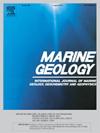Chicxulub impact tsunami megaripples, imaged in 3D seismic data: Distribution and characteristics on the northern Gulf of Mexico shelf and slope
IF 2.6
3区 地球科学
Q2 GEOSCIENCES, MULTIDISCIPLINARY
引用次数: 0
Abstract
Kinsland et al. (2021) presented images of megaripples derived from 200 sq. km (77 sq. mi) of petroleum industry 3D seismic data from the paleoshelf of central Louisiana, United States of America. The megaripples are interpreted to be the result of the Chicxulub Impact about 66 million years ago, the Cretaceous/Paleogene boundary. To investigate the presence and morphology of megaripples both farther up the paleoshelf and down over the paleoshelf edge onto the paleoslope we have obtained access to and have interpreted over 2400 sq. km (900 sq. mi) of additional 3D seismic data. Megaripples exist everywhere in the data investigated upon/within the, once, fluidized marl muds of a mass transport deposit which was mobilized by Rayleigh waves from the Chicxulub Impact, about an hour before the tsunami reached the northern Gulf of Mexico (Louisiana). We propose that the megaripples were formed in these thixotropic muds by fluid traction of the tsunami in much the same way that water waves are formed by the traction of wind and the forms persisted in the muds as the tsunami waned. We outline how studies similar to ours might lead to better understanding of tsunami effects and dangers in general and in those from tsunami resulting from oceanic impacts.
求助全文
约1分钟内获得全文
求助全文
来源期刊

Marine Geology
地学-地球科学综合
CiteScore
6.10
自引率
6.90%
发文量
175
审稿时长
21.9 weeks
期刊介绍:
Marine Geology is the premier international journal on marine geological processes in the broadest sense. We seek papers that are comprehensive, interdisciplinary and synthetic that will be lasting contributions to the field. Although most papers are based on regional studies, they must demonstrate new findings of international significance. We accept papers on subjects as diverse as seafloor hydrothermal systems, beach dynamics, early diagenesis, microbiological studies in sediments, palaeoclimate studies and geophysical studies of the seabed. We encourage papers that address emerging new fields, for example the influence of anthropogenic processes on coastal/marine geology and coastal/marine geoarchaeology. We insist that the papers are concerned with the marine realm and that they deal with geology: with rocks, sediments, and physical and chemical processes affecting them. Papers should address scientific hypotheses: highly descriptive data compilations or papers that deal only with marine management and risk assessment should be submitted to other journals. Papers on laboratory or modelling studies must demonstrate direct relevance to marine processes or deposits. The primary criteria for acceptance of papers is that the science is of high quality, novel, significant, and of broad international interest.
 求助内容:
求助内容: 应助结果提醒方式:
应助结果提醒方式:


